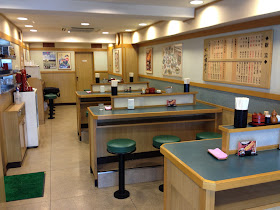Long, long ago in a land far away, Soba was made sometime during the Tokugawa period.
The ancient scrolls of the Wikipedities say:
Soba is the Japanese name for buckwheat. It is synonymous with a type of thin noodle made
from buckwheat flour, and in Japan can refer to any thin noodle (unlike thick wheat
noodles, known as udon). Soba noodles are served either chilled
with a dipping sauce, or in hot broth as a
noodle soup.
It takes three months for buckwheat to be ready for harvest, so it can be harvested four times
a year, mainly in spring, summer, and autumn. In Japan, buckwheat is produced
mainly in Hokkaido. Soba that is made with newly harvested
buckwheat is called "shin-soba". It is sweeter
and more flavorful than
regular soba.
In Japan, soba noodles are served in a variety of settings: they are a popular inexpensive
fast food at train stations throughout Japan, but are also served by expensive
specialty restaurants. Markets sell dried noodles and men-tsuyu,
or instant noodle broth, to make home preparation
easy. Some establishments, especially cheaper
and more casual ones, may
serve both soba and
udon as they are
often served
in a similar
manner.
Soba is the traditional noodle
of choice for
Tokyoites.
Yude Taro
In one place in Tokyo, that I go to everyday, the Soba Wars are in full swing. Let me introduce you to what I think are the major players. The station I am talking about is Hanzomon station on the Hanzomon Line. Leave the station at exit 5 to find both of these battling warriors within sixty-seconds walk from each other.
The first one is Yude-Taro. Just across the street from exit 5 as you walk out the station.
In my opinion, Yude- Taro is the empire of the soba shops; it is cheap, delicious and clean.
Yude Taro is spacious, extremely clean and has seating enough for you and a troop of Wookies.
Seating and standing room. Don't bother going there right at 12 pm on a workday, the place is packed!
As you can see the kitchen is extremely clean.
Buy your food tickets from the machines outside. The staff who handle your food never touch money.
The killer for Yude Taro is that the soba noodles are made on the premises. This place is cheap but just as delicious as a shop that costs twice the price.
Large Zaru soba (¥320) with Wakame (seaweed) total is ¥390. That's about $4.70
Wide menu that even includes curry rice and, of course, fried foods.
Window dressing
That's the commander of Yude Taro in front of a spotless kitchen and freshly fried veggies and fish.
..... And now, to the rebel base!
The next place that isn't quite as tasty (in my opinion) as Yude Taro is Komoro Soba (about a 45 second walk around the corner). BUT! Komoro Soba is cheaper by about ¥30 ($.50) a plate for the soba. If you are on a budget, then maybe Komoro Soba is for you. The exact same menu of Large Zaru soba with Wakame (seaweed) is ¥390 at Yude Taro (about $4.70) but at Komoro Soba it is ¥310 (about $3.90)... Now, if you are a cheap skate bastard like me, that makes a difference - ESPECIALLY when you are eating this healthy and wholesome food everyday for a week or a month!
Komoro Soba
To go to Komoro Soba, you need to walk out of the station and turn left (and left again at the corner) instead of walking across the street to Yude Taro)
The soba alone is ¥290 at Komoro Soba (about $3.68) while it is ¥360 (about $4.60) at Yude Taro. Yude Taro tastes a bit better (of course, their noodles are made on premises, but it depends on your pocketbook if it is worth it or not. And, unless you've eaten soba a lot, you might not be able to tell the difference!)
Komoro Soba is also immaculate and plenty of seating.
Kitchen is spotless too (I love Japanese restaurants!) Here is a photo of clone making soba.
As usual, the machines sell the goods and so these are not the droids you are looking for (unless, of course, you want a great meal for a great price!)
Map of the galaxy.... Go and seek.
There is no try. There is only do or not do.
Do try these great places to eat. May the force be with you!

















Mike, you Stare/Soba Wars geek! Love this blog entry!
ReplyDeleteYou are correct... the places are spotless! We have health inspectors here in Toronto who inspect every restaurant and give rd, yellow and green passes to places (who must hang it up at the front window of the place) so customers can be assured the place passes the muster... but I'm impressed by the Cantina(s) in Tokyo. Great looking food at a great price! I pay 4x that for my eel sushi. Then add in the $2.50 chocolate Pocky box and a Coke and I'm at $20 for my lunch.
We have no inexpensive dining/snack establishments anywhere in this city. We need something like this here... Great pics, too, Mike!
How did you find these places?
ReplyDeleteDo they have a Yelp-like website in Japan?
Or was it word-of-mouth?
P.S.: It's droids. You spelled it, drones.
Hi diego.a,
ReplyDeleteI'm a gambling man and I'll try just about anything once. If a restaurant has:
1) A clean kitchen
2) Women eating there
3) and a bargain price
then I'll try it... Of course, I have failed miserably before... But a pretty sure sign that a place is good if if there are women eating there, especially at crowded lunchtimes!